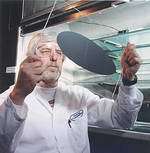Four Innovative Technologies from Argonne Win Research and Development 100 Awards

Four technologies developed or co-developed at Argonne have been recognized with Research and Development 100 Awards, which highlight some of the best products and technologies newly available for commercial use from around the world. This is the 41st year the technology awards have been given by Research and Development magazine to recognize the ''100 most technologically significant new products'' from the entries the magazine receive.
Argonne 's award-winning technologies are:
- Hydrogen transport membrane for the separation of pure hydrogen at high temperatures;
- Grancrete bonded phosphate ceramic construction spray-on structural cement and rapid construction process for low-cost housing;
- Three-dimensional multiphase computer code to model glass furnace design and performance;
- Powertrain system analysis toolkit to aid in design of advanced hybrid vehicles.
“In every case these awards represent the outcome of Argonne scientists working closely with industry to apply basic science to meet real needs of the market for benefits to users,” said Stephen D. Ban, director of Argonne's Office of Technology Transfer, which drives Argonne's efforts to link companies to appropriate Argonne-developed technologies. “The spectrum of exciting emerging products represented – from membranes for hydrogen production to low-cost housing in developing countries to advanced hybrid vehicle design – is indicative of the contributions scientists at Argonne and other national laboratories are making to improve the quality of life across the planet. Support of basic and applied science by the Department of Energy makes this spectrum possible and will greatly enhance the economy when these applications enter the marketplace.”
The hydrogen transport membrane for the separation of pure hydrogen at high temperatures was developed by Argonne scientist Balu Balachandran and colleagues Stephen Dorris and Tae Lee, in collaboration with Gary J. Steigel, Richard Dunst and John Winslow at the National Energy Technology Laboratory in Pittsburgh . This ceramic membrane provides pure hydrogen gas by selectively separating hydrogen from gas mixtures generated by fossil fuel-based processes. The membrane operates at the high temperatures and pressures required by such processes as coal gasification and methane reforming, without becoming embrittled by its interactions with hydrogen and sulfur.
The membrane was patented in 2003, and development of the technology is underway with industrial partners Eltron Research, Inc., and ITN Energy Systems, Inc. The technology is expected advance the “hydrogen economy” by enabling the economical and environmentally friendly production of hydrogen from carbon-based feedstocks, permitting the highly efficient generation of electricity via fuel cells.
Grancrete spray-on structural phosphate ceramic cement was developed by Argonne scientist Arun Wagh in collaboration with Jim Paul of Casa Grande International of Mechanicsville, Va. The Grancrete magnesium-phosphate cement powder would be mixed at a construction site with water and sand into a slurry that would be sprayed onto polystyrene foam sheets in frames and set as structural cement.
Within two to four hours, Grancrete system forms a rigid, long-lasting structural wall or ceiling that is permanently bonded to the panels. The resulting structures make it possible to offer long-lasting, easily maintained housing to a large segment of the world's population that could not previously obtain adequate shelter. A Grancrete structure of approximately 800 square feet, for example, would cost $6000 in labor and materials to construct.
The Glass Furnace Model was developed by Argonne scientist Brian Golchert and colleagues Steve Lottes, Michael Petrick, Chenn Qian Zhou and the late Shen Lin Chang as a three-dimensional computer code, developed for the glass industry to evaluate furnace design, performance and operation.
The code is used to generate a computer simulation that allows engineers to “visualize” critical heat transfer, flow and reaction patterns within the interior of a glass furnace. The simulation is used to conduct extensive experiments, inexpensively on the computer, by varying key operating and design parameters to determine their impact of overall furnace performance and lead to higher efficiency and increased productivity.
The Powertrain System Analysis Toolkit allows vehicle designers to develop realistic hybrid and powertrain control systems and assess performance of components. Developed by Argonne engineers Aymeric Rousseau, Phillip Sharer and Sylvain Pagerit, the computer simulation provides accurate performance, fuel economy and emissions simulations, allowing automotive and truck manufacturers and their suppliers to select appropriate advanced technologies, bringing them more quickly to the market in improved hybrid vehicle systems.
The Toolkit was released in 2003, and licensed not only to industry, including Ford Motor Co., DaimlerChrysler Corp., General Motors, Exxon/Mobil, and Lockheed Martin, and also to universities using the program to develop designs for student competitions.
The nation’s first national laboratory, Argonne National Laboratory conducts basic and applied scientific research across a wide spectrum of disciplines, ranging from high-energy physics to climatology and biotechnology. Since 1990, Argonne has worked with more than 600 companies and numerous federal agencies and other organizations to help advance America's scientific leadership and prepare the nation for the future. Argonne is operated by the University of Chicago for the U.S. Department of Energy's Office of Science.
Source: Argonne National Laboratory
















